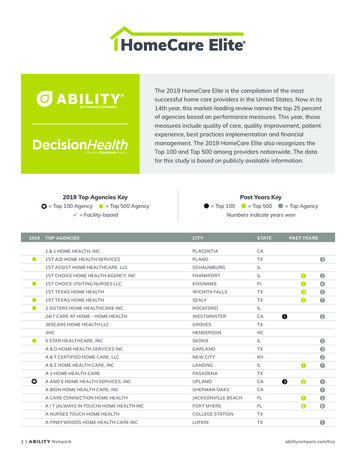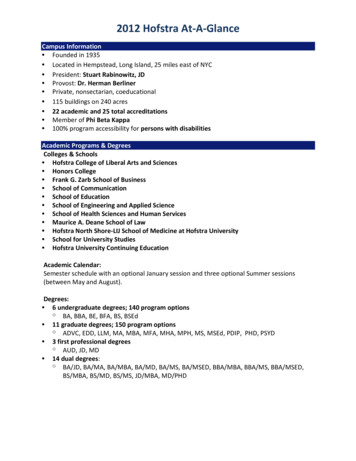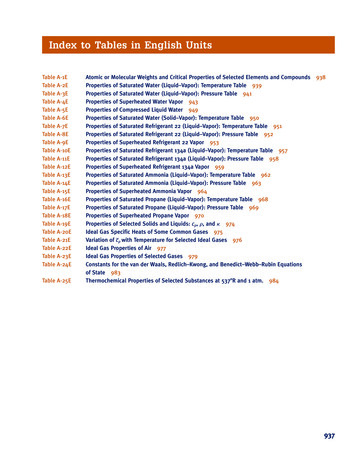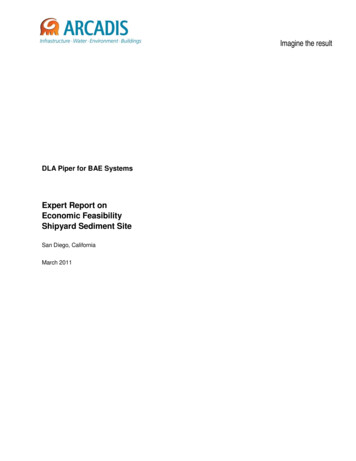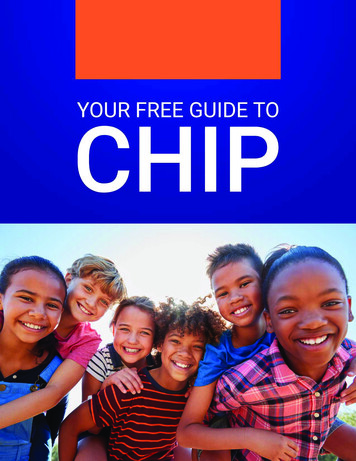
Transcription
1
Chipassistance.org is privately owned and is not affiliated with any government agency.While we are not affiliated with the government in any way, our team of writers have researched the U.S. Children’s HealthInsurance Program to create this guide to assist consumers.TABLEOF CONTENTSCHIP 101 CHIP and Medicaid The Center for Medicaid and CHIP Services (CMCS) CHIP Contact Information by Location 5668Types of CHIP Programs 12CHIP Eligibility Requirements Nationwide Requirements 16How to Apply for CHIP 28Nationwide CHIP Benefits Location-Specific Requirements CHIP Income Guidelines by Location Location-Specific CHIP Benefits CHIP Waiting Periods CHIP Medical Funding Requests for Denied Services Appealing a Medical Service Denial Information and Documents Applying in U.S. States and Territories Applying as a Native American or Alaska Native CHIP Costs in U.S. States and Territories CHIP Copayments in U.S. States and Territories CHIP Premiums in U.S. States and Territories CHIP Costs for Native Americans and Alaska Natives CHIP Dental Insurance 161617172225272728303940414548492
CHIP Vision Insurance Why are vision health services important? 5050CHIP Health Insurance Coverage for Pregnant Women CHIP Income Eligibility for Pregnant Women How CHIP Covers Pregnant Women Prenatal Care Prenatal Checkups Prenatal Tests Prenatal Vitamins Labor and Delivery Care Stage 1: Early and Active Labor Stage 2: Birth Stage 3: Placenta Delivery Postpartum Care Postpartum Changes Postpartum Checkup Postpartum Coverage by Location 51CHIP Denials and Appeals 62Reasons for CHIP Application Denials Appealing a CHIP Application Denial Appealing an Application Denial in Puerto Rico Appealing an Application Denial in the U.S. Virgin Islands Expedited Appeals CHIP Special Enrollment Periods When to Contact Your Local Medicaid or CHIP Agency How to Change Your CHIP Health Plan Why would you change your CHIP Health Plan? Changes in CHIP Eligibility Reporting Income and Household Changes After Enrollment When do my health plan changes become effective? Changes Requested by Your Health Plan Your Guide to Preventive Care for Your Child Doctor Checkups The First Appointment 68697070713
What to Expect Vaccines Vaccine Schedule Birth - 11 months 12 - 23 months 2 - 6 years 11-12 years Child Mental Health Resources What are mental health resources? How do I know which service is right for my child? Inpatient Mental Health Services Outpatient Mental Health Services Will my child receive mental health counseling? Individual Therapy Group Therapy Family Therapy Medication Management Crisis Intervention Services Tips for Choosing a Pediatrician Talk to Your Child’s Current Pediatrician Ask for Referrals What if I cannot find a pediatrician that accepts CHIP? What do I do when I find a pediatrician? 71717172727272737373737374747474747575757575764
CHIP 101The Children’s Health Insurance Program (CHIP) provides low-cost healthcare coverage to millions of families inthe United States. Through CHIP, parents and guardians can obtain important insurance benefits for their children.Benefits cover annual check-ups, hospital visits, and other medical needs which will be explored in this guide.Any child who qualifies for CHIP is also automatically eligible for CHIP dental and vision insurance. In some cases,pregnant women may also be eligible for CHIP health care benefits. All CHIP services are provided through CHIPparticipating providers. Not all doctors and medical facilities accept CHIP patients. Enrollees must only receivecare from doctors who participate in the CHIP program.Eligibility for CHIP is based on factors like family income, household size and age. Income limits are determined byeach state or territory using a uniform set of standards based on Modified Adjusted Gross income (MAGI), whichtakes into account certain deductions like student loan interest deductions.CHIP is a federal program that is administered through location-specific CHIP programs. Anyone interested inreceiving CHIP benefits can apply through their state’s specific CHIP program or through the national HealthInsurance Marketplace. The application process requires individuals to provide personal information includingtax information, income information and identification. If approved, beneficiaries will receive a CHIP enrollmentcard to access their health care benefits. If CHIP coverage is denied, applicants can request an appeal.5
CHIP and MedicaidOften confused for one another, CHIP and Medicaidare both federally funded healthcare programs.However, they have distinct differences in eligibility,coverage options and funding.Both CHIP and Medicaid provide health coverage andservices to children 18 years of age or younger. However,Medicaid has lower income limits, which means it isrestricted to extremely low-income households. Toqualify for Medicaid, a family’s income must be lessthan or equal to 133% of the Federal Poverty Level (FPL).The chart below contains the maximum yearlyhousehold income limits based on household size in2020.Household Size133% FPL1 16,9712 22,9293 28,8884 34,8465 40,8046 46,7637 52,7218 58,680Children belonging to families whose income isgreater than the income limit to qualify for Medicaidcan be eligible for coverage through CHIP, whichhas higher income limits. CHIP income limits varyby location, but most extend coverage to familiesat 200% of the FPL. Families who make more thanthe limits in the table before can still be considered“low-income” and still need affordable health care.Because of this, far more children across the countryare eligible for health coverage through CHIP thanthrough Medicaid.You can see income limits for the different statesand territories in the section called “CHIP IncomeGuidelines by Location” on page 17 of this guide.The Center for Medicaid and CHIPServices (CMCS)At a federal level, the Center for Medicaid andCHIP Services (CMCS) is responsible for workingin partnership with states/territories, insuranceproviders and families to support effective highquality health insurance programs. The CMCSoperates within the headquarters of the Centers forMedicare and Medicaid Services (CMS).Currently, there are 10 regional contacts for CMSagencies responsible for working closely withMedicaid and CHIP offices. Each of these officesgives beneficiaries and applicants the chance toconnect regarding any questions they may have orreports (such as fraud) they may want to file.See the chart below for contact information for all 10regional offices and their jurisdictions.6
Regional OfficeLocations CoveredContact InformationRegion One – BostonConnecticut, Maine, Massachusetts,New Hampshire, Rhode Island andVermontJFK Federal Building, Ste. 2325Boston, MA 02203617-565-1299ROBOSDMCH@cms.hhs.govRegion Two –New YorkNew Jersey, New York, Puerto Rico, andVirgin Islands26 Federal Plaza, Room 3811New York, NY 10278(212) 616-2400RONYDMCH@cms.hhs.govRegion Three –Delaware, District of Columbia,150 S. Independence Mall WestPhiladelphiaMaryland, Pennsylvania, Virginia, andWest VirginiaPhiladelphia, PA 19106(215) 861-4155ROPHIDMCH@cms.hhs.govRegion Four – AtlantaAlabama, Florida, Georgia, Kentucky,Mississippi, North Carolina, SouthCarolina, and Tennessee61 Forsyth Street, SW, Suite 4T20Atlanta, Georgia 30303-8909(404) 562-7359ROATLMCD@cms.hhs.govRegion Five - ChicagoIllinois, Indiana, Michigan, Minnesota,Ohio, and Wisconsin233 North Michigan Avenue, Suite 600Chicago, Illinois 60601(312) 353-1133R5DMCH@cms.hhs.govRegion Six – DallasArkansas, Louisiana, New Mexico,Oklahoma, Texas1301 Young St. Suite 714Dallas, TX 75202(214) 767-6495RODALDMCH@cms.hhs.govRegion Seven –Kansas CityIowa, Kansas, Missouri, and Nebraska601 E. 12th Street, Suite 355Kansas City, MO 64106(816) 426-5925ROKCMMCH@cms.hhs.govRegion Eight - DenverColorado, Montana, North Dakota, SouthDakota, Utah, and Wyoming1961 Stout Street, Room 08-148Denver, CO 80294(303) 844-0634RODENDMCH@cms.hhs.gov7
Regional OfficeLocations CoveredContact InformationRegion Nine – SanFranciscoArizona, California, Hawaii, Nevada,Pacific Territories90 – 7th Street, Suite 5-300San Francisco, CA 94103-6706(415) 744-3568ROSFOMCD@cms.hhs.govRegion Ten - SeattleAlaska, Idaho, Oregon, and Washington701 Fifth Avenue, Suite 1600Seattle, WA 98104(206) 615-2326SEARODMCH@cms.hhs.govCHIP Contact Informationby LocationCHIP is a nationwide health insurance program, but each state and U.S. territory is responsible for managing itsown specific plans. Most states have different names for their version of CHIP. In the chart below, you will find thespecific name for each state’s CHIP plan as well as current contact information for CHIP agencies in each stateand territory.LocationProgram NameOffice Phone NumberALLKids1 (800) 362-1504AlaskaDenali KidCare1 (877) 543-7669ArizonaKidsCare1 (855) 432-7587ArkansasARKids First1 (888) 474-8275CaliforniaMedi-Cal for Kids1 (800) 541-5555ColoradoChild Health Plan Plus (CHP )1 (800) 221-3943Husky Health1 (855) 805-4325Healthy Children Program1 (800) 996-9969AlabamaConnecticutDelaware8
LocationProgram NameOffice Phone NumberHealthy Families Insurance1 (800) 620-7802FloridaKidCare1 (888) 540-5437GeorgiaPeachCare for Kids1 (888) 295-1769HawaiiCHIP1 (877) 628-5076IdahoIdaho Health Plan for Children1 (877) 456-1233IllinoisAll Kids1 (800) 843-6154IndianaHoosier Healthwise1 (800) 403-0864Healthy and Well Kids in Iowa (HAWKI)1 (800) 257-8563KanCare1 (800) 792-4884KentuckyKCHIP1 (877) 524-4718LouisianaLACHIP1 (888) 342-6207MaineCubCare1 (855) 797-4357Maryland Children’s Health Program(MCHP)1 (855) 642-8572MassHealth1 (800) 841-2900MIChild1 (888) 988-6300MinnesotaMinnesotaCare1 (800) 657-3629MississippiCHIP1 (800) 421-2408MissouriMO HealthNet for Kids1 (855) 373-9994MontanaHealthy Montana Kids (HMK)1 (888) 706-1535District of ColumbiaIowaKansasMarylandMassachusettsMichigan9
LocationProgram NameOffice Phone NumberCHIP1 (855) 632-7633Nevada Check Up1 (877) 638-3472CHIP1 (800) 852-3345New JerseyNJ FamilyCare1 (800) 701-0710New MexicoNew MexiKids1 (855) 637-6574Child Health Plus1 (855) 355-5777North CarolinaHealth Choice for Children1 (800) 662-7030North DakotaCHIP1 (800) 318-2595OhioHealthy Start1 (800) 324-8680OklahomaSoonerCare1 (800) 987-7767Oregon Health Plan (OHP)1 (800) 699-9075CHIP1 (866) 550-4355Government Health Plan/CHIP1 (787) 641-4224 or 1( 787) 765-2929RIte Care1 (855) 697-4347South CarolinaPartners for Healthy Children (PHC)1 (888) 549-0820South DakotaCHIP1 (800) 305-3064CoverKids1 (800) 318-2596TexasTexas Children’s Health Plan1 (877) 541-7905UtahCHIP1 (877) 543-7669Dr. Dynasaur1 (800) 250-8427NebraskaNevadaNew HampshireNew YorkOregonPennsylvaniaPuerto RicoRhode IslandTennesseeVermont10
LocationProgram NameOffice Phone NumberCHIP1 (340) 715-6929Family Access to Medical InsuranceSecurity (FAMIS)1 (855) 242-8282WashingtonApple Health for Kids1 (800) 562-3022West VirginiaWVCHIP1 (877) 982-2447WisconsinBadgerCare Plus1 (800) 362-3002WyomingKidCare CHIP1 (855) 294-2127U.S. Virgin IslandsVirginiaNote: Guam, the Northern Mariana Islands and American Samoa do not have designated CHIP programs forchildren whose parents earn too much to qualify for Medicaid. However, these territories do offer Medicaidassistance. Find contact information for each of these territories below: Guam Department of Public Health and Social Services: (671) 735-7224 Northern Mariana Islands Department of Public Health, Community Guidance Center: (670) 664-3005 American Samoa Medicaid Program: (684) 633-4818If you are a Native American or Alaska Native belonging to a federally recognized tribe, contact the CHIP officein your state for general questions or CHIP program information. You can find a list of federally-recognized tribeshere: x.11
Types ofCHIP ProgramsThere are three types of CHIP programs. Each state or territory utilizes one of the three options: CHIP as an expansion of Medicaid Separate CHIP Combination of separate CHIP MedicaidWhen CHIP is administered as an expansion of Medicaid, states can offer different levels of coverage based onthe child’s age or the family’s income. States must adhere to federal guidelines for costs of services.When CHIP is offered as a separate program, states are given the freedom to design benefit packages that lookmore like commercial insurance programs. States also get to determine how much beneficiaries will pay formedical services.12
Most states offer CHIP as a combination of the two options listed above. Combination plans adhere to Medicaidcost-shares and income eligibility requirements, but states can design packages for families with different levelsof income.The chart below shows how each state and territory administers CHIP as of 2020:LocationCHIP as an Expansion ofMedicaidSeparate CHIPAlabamaAlaskaCombination CHIP Arizona Arkansas California Colorado Connecticut DelawareDistrict of Columbia Florida Georgia Hawaii Idaho Illinois 13
LocationCHIP as an Expansion ofMedicaidSeparate CHIPCombination CHIPIndiana Iowa Kansas Kentucky Louisiana Maine Maryland Massachusetts Michigan Minnesota Mississippi Missouri Montana Nebraska Nevada New Hampshire New JerseyNew MexicoNew York 14
LocationCHIP as an Expansion ofMedicaidSeparate CHIPCombination CHIPNorth Carolina North Dakota Ohio Oklahoma Oregon Pennsylvania Puerto Rico Rhode IslandSouth Carolina South Dakota Tennessee Texas Utah Vermont Virgin Islands VirginiaWashington West Virginia Wisconsin Wyoming 15
CHIPEligibility RequirementsEach state or territory sets its own CHIP eligibilityguidelines. Some requirements are standard across thecountry, while others vary by location. Before submittingyour application, review your state’s requirements andincome limits to make sure you qualify. Routine checkups Immunizations (shots) Prescription drugs Dental care Vision careSee the section called “CHIP Income Guidelines byLocation” on page 17 of this guide for informationabout specific income limits.NationwideRequirements Doctor visits Emergency services Inpatient and outpatient hospital care “Inpatient” is when an individual is admittedinto the hospital. “Outpatient” is when an individual continuesto receive care once they have left thehospital.There are nationwide eligibility requirements that alllocations adhere to. To qualify for CHIP, you must have: A child who is 18 years of age or younger. U.S. citizenship or approved immigration status. Proof of your legal status, such as a passport ora permanent resident card.Nationwide CHIP BenefitsThe following list encompasses the standard CHIPbenefits administered in each state or territory:16
Location-SpecificRequirementsSince CHIP is administered at the state/territory level,there are state-specific requirements that applicantsmust meet before they receive benefits. Applicantsmust meet both their state’s requirements and thenational requirements listed above.person income limit amount for each additionalfamily member. You can use this figure to find thetotal income limit for your larger household using thesteps below:01Locate your state or territory in the chartbelow.02Find the highest income limit listed foryour state.To qualify for your local CHIP program, you must: Some states list income limitsfor up to 12 members whileother states stop at six. Meet your location’s established incomeguidelines. Have proof of state residency, such as a driver’slicense or utility bill.03 Adhere to your state-specific CHIP waitingperiod. If your state lists the incomelimits for up to eight householdmembers, but there are 10members in your household, youhave two additional members.CHIP Income Guidelines by LocationCHIP income limits are different in every location.Income limits may change each year. It is commonfor a family to qualify one year and become ineligiblethe next due to a state’s changes to its income limitsor due to a change in the family’s income.Each state or territory determines income limitsbased on the size of the household. Household sizeis calculated by adding up the total number of familymembers living in the home.Most states list income limits for households withup to eight members. For families with more thaneight household members, states provide a per-Determine how many additionalhousehold members you have.04Multiply the number of additionalmembers by the dollar amount locatedin the “additional” column of the table.05Add the answer you get in step four tothe highest income limit listed for yourstate.In the chart below, you will find the 2020 incomelimits for every state, including those for the U.S.Virgin Islands and Puerto Rico, based on the size ofthe household.17
A single asterisk (*) means that the income limit for that state is listed annually.Double asterisks (**) signify that the income limit varies depending on the Federal Poverty Level (FPL).Triple asterisks (***) signify that the information was intended to be included but was not available.No asterisks mean that the income limit for that state is listed monthly.Note: Certain states may have lower limits for infants or varying income limits based on the age of the child.Household Size1AL234567892,644 -3,189 -3,734 -4,279 -4,824 -5,369 ,6204,3675,1145,860///////AR2,196.51 2,972.99 3,751.58 4,528.06 5,304.54 6,083.13 6,859.61 7,636.09 3,32564,37575,42586,47597,525108,575 ////11,050CT*25,104 - 33,989 - 42,873 - 51,757 - 60,641 - 69,525 - /////////////CT*31,724 - 42,951 - 54,178 - 65,405 - 76,631 - 87,858 - /(HUSKY BLEVEL2)54,17865,40576,631/Addtl2,099 -42,951/123,37131,724/111,554 -(HUSKY BLEVEL1)/10583 25DC*38,28051,72065,16078,60092,040105,480 118,920 132,360 145,800 159,240 172,680 186,120 70FL*/** 16,980 - 22,932 - 28,896 - 34,848 - 40,812 - 46,764 - 52,728 - 58,680 - 64,644 - 70,608 - 492,07288,248/97,200/106,16418
Household Size1234567GA*29,352HIDetermine your eligibility by going to: 8585,567IL**1,530 -2,071 -2,613 -3,154 -3,696 l102,061 ////10,3876,2776,986////709////////////////21,310 - 28,792 - 36,273 - 43,755-51,237 - 58,718 - 66,200 - 73,681 - /////38,53552,06565,59479,12492,654106,183 119,713 ,308 -3,118 -3,928 -4,738 -5,548 -6,359 -7,169 -7,979 3 -2,328 -2,933 -3,537 -4,142-///////605 -2,2653,0613,8564,6515,446ME39,7398796MDHousehold income must fall below 322% of the Federal Poverty Level (FPL), but in some cases, it must be below 211% of the FPL.MA*37,47050,73063,99077,25090,510103,770 117,030 130,290 122107,277 119,432 69////781MO**1,595 -2,155 -2,715 -3,275 -3,835 -4,395 -4,955-5,515 -6,075 -6,635 -7,195 -7,755 47597,525108,575 ////MT*86,86011,05019
Household 34069,18078,02086,860////8,840NH**2,085 -2,816 -3,548 -4,280 -5,012 -5,743 -6,475 -7,207 564 -2,112 -2,661 -3,210 -3,759 -4,308 -//////549 -3,7755,1016,4267,7519,07710,4021,064 -1,437 -1,810 -2,184 -2,557 -2,930 -3,1904,3115,4306,5507,6718,7901,638 -2,213 -2,788 -3,363 -3,938 -4,2545,7477,2408,73410,227/1,875 -2,365 -2,854 -3,344 //////4,513 -5,088 -5,663 -////575 OR3,2444,3825,5216,6607,7988,937///////PA*20,034 -27,067 -34,101 -41,134 -48,168 -55,202 -62,235 -69,269 -76,302 - 83,336 - ,537152,604 166,672PR1,1001,3001,5001,700//////200RIHousehold income must be up to 261% of the Federal Poverty Level (FPL) for children 18 years of age or younger. For pregnant women,//income must be at 253% of the FPL.SC2,211.73 2,988.26 3,764.80 4,541.33 5,317.86 6,094.40 6,870.93 7,647.46 ////20
Household ,391/////USVI548.40739.19929.981,120.77 71.20 4,554.85 5,738.50 6,921.20 8,104.85 9,288.50 10,472.20 11,655.85 /766WA2,233 -3,017 -3,801 -4,585 -5,369 -6,153 -///////3,3184,4835,6486,8127,9779,142/2,155 -2,715 -3,275 -3,835 -4,395 -4,955 -//////4,3105,4306,5507,6708,7909,910/373.33 -WVWI**10111,063.33 1,436.67 1,810 -2,183.33 2,556.67 2,930 -3,303.33 3,676.67 4,050 -4,423.33 /-----5,4303,189.99 4,310.01WY5,02892,1272,874-8,7906,549.99 7,670.013,6204,3675,114-12,1509,909.99 1008,847///If you are a Native American or Alaska Native, you are held to the same income guidelines for the state in whichyour tribe is located. Use the table above to see if you qualify for CHIP benefits. For more information or to contactyour state’s CHIP department, refer to page 8 of this guide.21
Location-Specific CHIP BenefitsBeyond the nationwide standard coverage, local agencies may choose to provide additional covered servicesthrough CHIP. In the chart below, you will find a list of additional medical services provided by each state or territory.Note: Some of these services may require referrals from primary care physicians. A referral is a notice of approvalfor medical services not provided by a primary care physician.TherapyMedicalEquipmentand cesPregnancyand /orPostpartumcare Alaska Arizona Arkansas California Colorado Connecticut Delaware District ofColumbia Florida MentalHealthServicesAlabamaLocationGeorgia FamilyPlanning Hawaii Idaho 22
TherapyMedicalEquipmentand cesPregnancyand /orPostpartumcareFamilyPlanning Indiana Iowa Kansas Kentucky Louisiana Maine Maryland Massachusetts Michigan Minnesota Mississippi Missouri Montana Nebraska Nevada NewHampshire New Jersey MentalHealthServicesIllinoisLocation 23
MentalHealthServicesNew MexicoPregnancyand /orPostpartumcareTherapyMedicalEquipmentand SuppliesSubstanceAbuseTreatment New York NorthCarolina North Dakota Ohio Oklahoma Oregon Pennsylvania Puerto Rico Rhode Island South Carolina South Dakota Tennessee Texas Utah Vermont Virgin Islands Virginia Washington LocationTransportationServicesFamilyPlanning 24
MentalHealthServicesTherapyMedicalEquipmentand SuppliesSubstanceAbuseTreatmentWest Virginia Wisconsin Wyoming LocationTransportationServicesPregnancy and/or PostpartumcareFamilyPlanning CHIPWaiting PeriodsSome states require children to be uninsured for a period of time before they are eligible for CHIP coverage. By law,the state-specific waiting period can be no longer than 90 days. See the chart below for the list of states that haveCHIP waiting periods, including the duration of each waiting period and any exceptions to this rule. States that arenot listed below do not have waiting periods.StateWaiting PeriodExceptionsArizona90 days Newborns Anyone enrolled in Children’s RehabilitationServices Native Americans receiving services from IHSor a 638 Tribal Facility Anyone who reached their lifetime insurance limitArkansas90 days Unborn childrenFlorida2 months Anyone who reached their lifetime insurance limit Victims of domestic violence Children who have exhausted coverage underCOBRA Children with special health care needsIllinois90 days Babies younger than 1 year of age Families at or above 209% of the FederalPoverty Level (FPL)Indiana90 days Families at or below 158% of the FederalPoverty Level (FPL)25
StateWaiting PeriodExceptionsIowa30 days Families at or below 181% of the FederalPoverty Level (FPL) Children who are only eligible for dentalcoverage Anyone who reached their lifetime insurance limit Children who have exhausted coverage underCOBRALouisiana90 days Unborn children Anyone who reached their lifetime insurancelimit Children with long-term disabilitiesMaine90 days NoneNew Jersey90 days Pregnant women Families at or below 200% of the FederalPoverty Level (FPL) Applicants who lost their insurance coveragedue to abuse Children who have exhausted coverage underCOBRASouth Dakota90 days NoneTexas90 days Unborn children Children who have exhausted coverage underCOBRA Loss of coverage in the Texas EmployeeRetirement SystemUtah90 days Applicants who voluntarily terminated theirCOBRA coverage Non-custodial parents who voluntarily terminatedtheir coverage Applicants who voluntarily terminated insuranceoutside of Utah Applicants who voluntarily terminated a limitedhealth insurance planWyoming1 month None26
CHIP Medical Funding Requestsfor Denied ServicesCHIP children who require special medical attentionor need extensive treatment may not be automaticallycovered for certain services they need through theirstate’s program, even if they have already beenaccepted into CHIP.If you receive a CHIP coverage denial for certainmedical services to treat your child’s special medicalcondition, you need to submit an appeal and requestfunding to get those specific services covered byCHIP.Appealing a Medical Service DenialYou can appeal a medical service funding denialon behalf of your child for any service or treatmentnot considered “medically necessary” by your state.States and territories determine which services arereasonable and necessary for the treatment of anygiven condition. More complicated or expensiveprocedures may be initially rejected for coverage bythe CHIP program. If you disagree with your state’sdecision, you can file an appeal to have CHIP coverthose medical expenses. Appeals are not guaranteedand may be denied by the CHIP agency.If you are denied CHIP coverage for your child’smedical services, you will receive a denial letter inthe mail. It will include a deadline for appealing thedecision as well as the specific steps you must taketo begin the appeal.After submitting an appeal, your local CHIP agencywill send you an acknowledgement letter statingthat the denial will be reviewed. Most appeals arereviewed and processed within 30 days of the datethat the original appeal was received.During the appeal process, you must remainenrolled in your CHIP coverage plan. If you do notstay enrolled or fail to pay your premiums, you willlose your CHIP health coverage. You may not be ableto re-enroll in CHIP immediately after the appeal,even if your appeal is granted. For more informationabout paying CHIP premiums, please refer to thesection called “CHIP Premiums in U.S. States andTerritories” on page 45 of this guide.While your appeal is being reviewed by your localCHIP agency, you should start gathering anydocuments that prove your child’s medical servicesand treatment are necessary for his or her healthcondition. These include: Written authorizationsproviders.fromhealthcare Dates of medical care provided. Prescription notices.Your local CHIP agency will evaluate these medicaldocuments to reconsider the initial decision. Oncethe CHIP agency has come to a final decision, you willeither receive a notice of approval or another denialletter.27
How toApply for CHIPYou can apply to CHIP year-round. Also, if you apply to Medicaid, your Medicaid application is automaticallyexamined to identify whether your children are eligible for CHIP coverage.The application process varies from location to location.Information andDocumentsWhen applying to CHIP, you must provide extensive personal and financial information as well as documents toprove that you qualify: Proof of full name Social Security card, driver’s license or U.S. passport Proof of date of birth Birth certificate Proof of citizenship Passport, Permanent Resident Card, Certificate of Naturalization or Certificate of Citizenship28
Proof of residency Utility bill, property tax, rent receipt or mortgage documents Proof of income Pay stubs, bank statement, tax return, W-2 or 1099 forms Proof of employment Pay stubs, signed and dated letter from employer on company letterhead Proof of relation Adoption papers or marriage recordsNote that applicants must provide all sources of income, including earned income (such as a salary) andunearned income. Unearned income is money that is received but that is not payment for work, such as: Inheritance Unemployment benefits Social Security benefits Alimony Child support Pensions29
Applying inU.S. States and TerritoriesBecause each location sets its own regulations for managing CHIP, the application process can vary greatly fromone location to the next. Your local CHIP agency may or may not accept applications online, in person or by mail.To find out how to submit an application, review the applicable section below.01Alab
MassHealth MinnesotaCare MO HealthNet for Kids MIChild CHIP Healthy Montana Kids (HMK) 1 (800) 841-2900 1 (800) 657-3629 1 (855) 373-9994 1 (888) 988-6300 1 (800) 421-2408 1 (888) 706-1535 District of Columbia Healthy Families Insurance 1 (800) 620-7802 Location Program Name Office Phone Number




